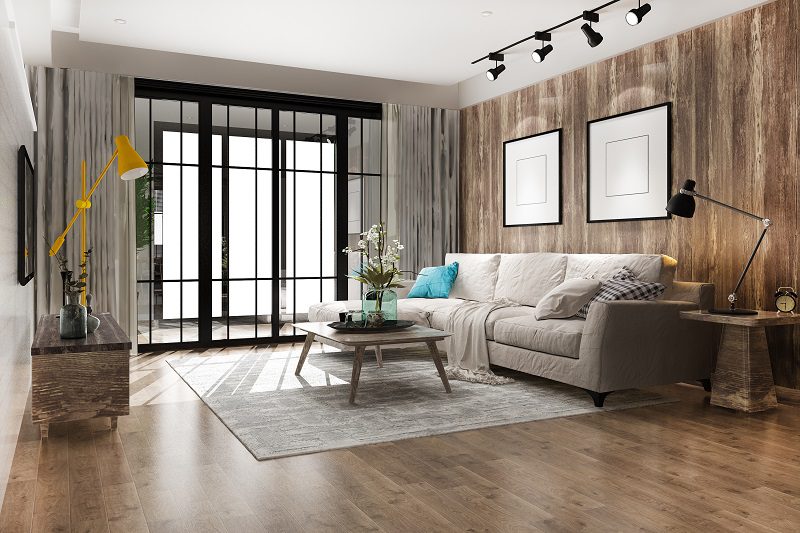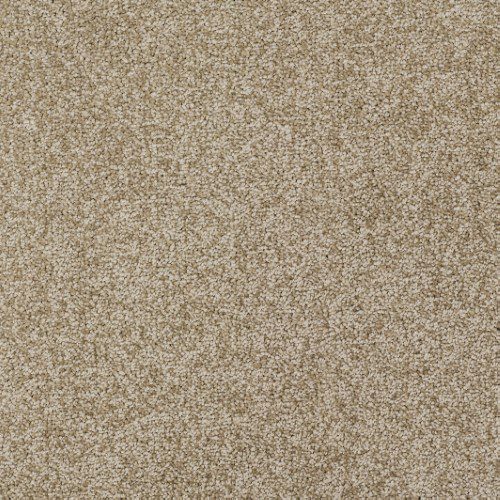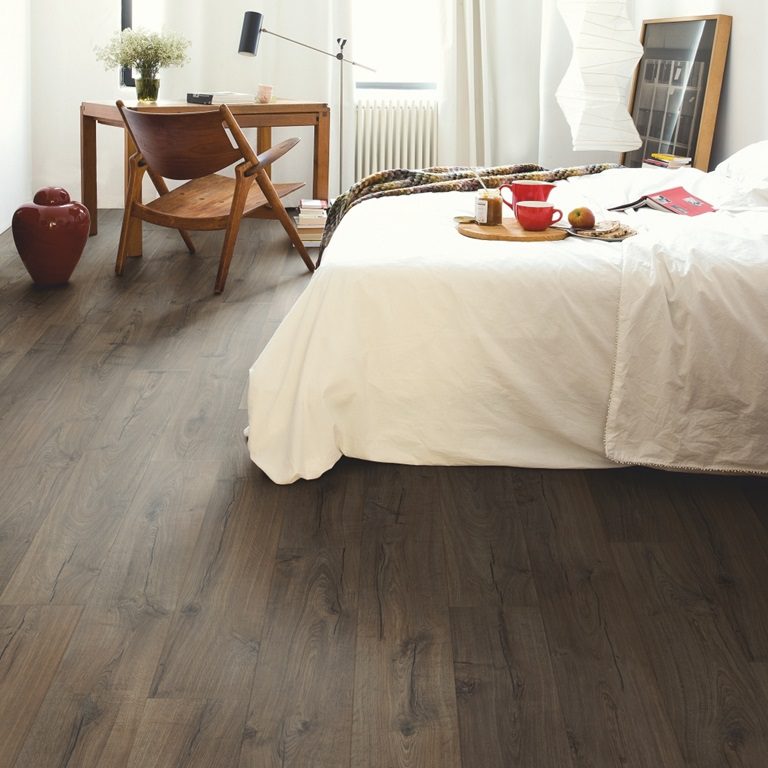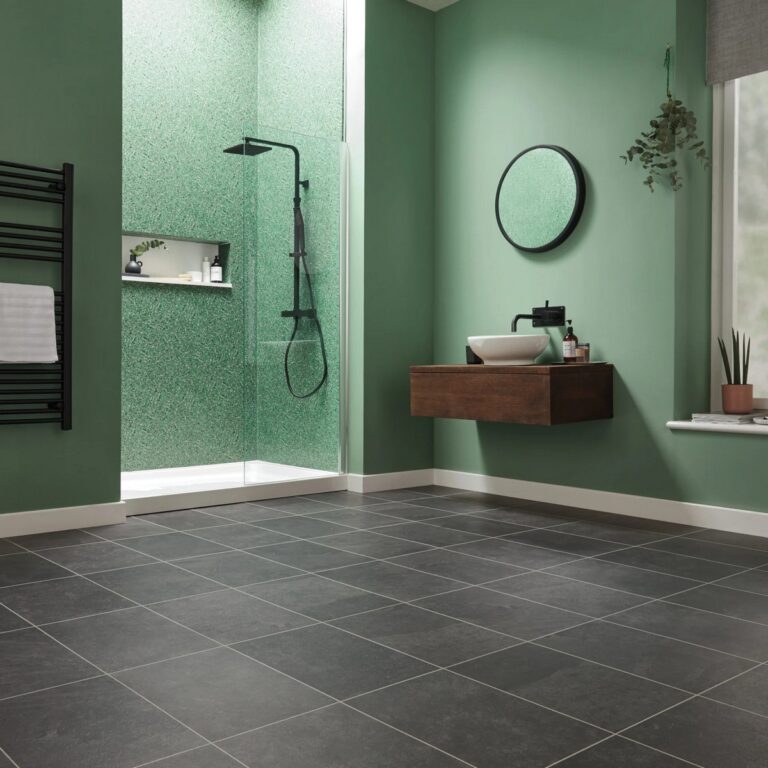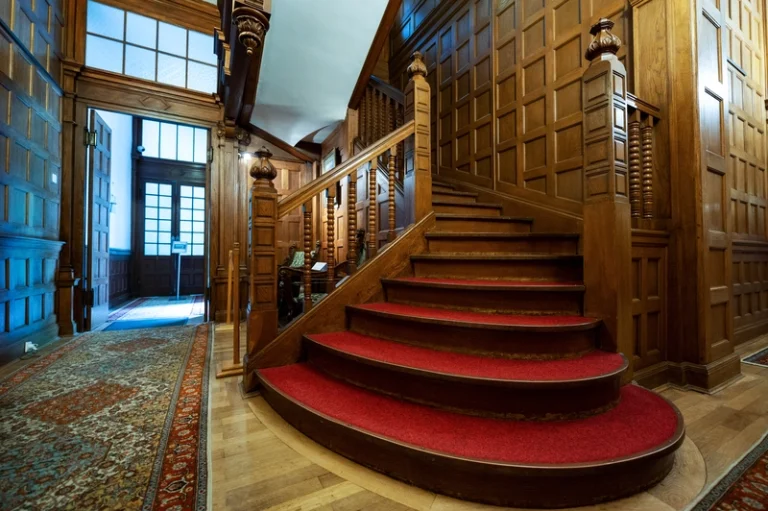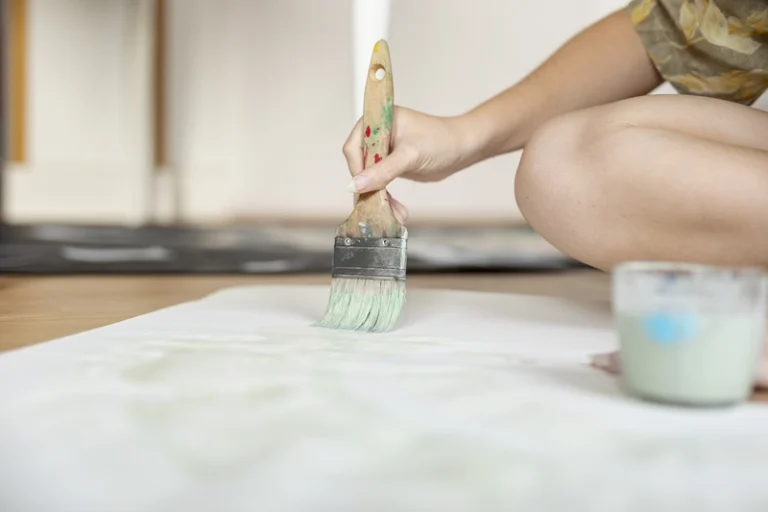Looking to update the flooring in your home? Vinyl flooring may be the perfect solution for you. Explore the different types of vinyl flooring available, including Luxury Vinyl Tile (LVT), Vinyl Sheet Flooring, Vinyl Plank Flooring, Vinyl Tile Flooring, also Peel and Stick Vinyl Flooring.
So, what are the different kinds of vinyl flooring? Get tips on how to choose the right type of vinyl flooring for your space, discuss the benefits and drawbacks of vinyl flooring, and make an informed decision for your home.
What Is Vinyl Flooring?
Vinyl flooring is a synthetic flooring material that is a popular choice for residential and commercial spaces due to its durability, affordability, and versatility. It is made from PVC (polyvinyl chloride) and other synthetic materials, making it resistant to water, stains, and wear.
During the manufacturing process, the PVC material is heated and moulded into sheets or tiles, resulting in different types of vinyl flooring such as LVT (Luxury Vinyl Tile) and LVP (Luxury Vinyl Plank). Companies like Karndean are renowned for their high-quality vinyl floors that mimic the appearance of wood, stone, or tile.
Consumers prefer vinyl flooring not only for its aesthetic appeal but also for its easy maintenance and long-lasting performance. The variety of colours, patterns, and textures available in vinyl flooring options cater to diverse design preferences, making it a versatile choice for interior spaces.
Types of Vinyl Flooring
What are the different types of luxury vinyl flooring? There are several types of vinyl flooring available on the market, each offering unique features and benefits to suit different preferences and requirements. The main types include Luxury Vinyl Tile (LVT), Vinyl Sheet Flooring, Vinyl Plank Flooring, Vinyl Tile Flooring, and Peel and Stick Vinyl Flooring.
Luxury Vinyl Tile (LVT) stands out for its high-end look and durability, making it a popular choice for residential and commercial spaces alike. On the other hand, Vinyl Sheet Flooring is known for its seamless installation, making it suitable for larger areas with minimal seams. Vinyl Plank Flooring replicates the look of hardwood with ease of maintenance, perfect for high-traffic areas.
Vinyl Tile Flooring provides versatility in design options, ideal for creating unique patterns and styles. Peel and Stick Vinyl Flooring offers a quick and easy installation method, great for DIY enthusiasts looking to update their floors swiftly.
a. Luxury Vinyl Tile (LVT)
One of the best types of vinyl flooring is Luxury Vinyl Tile (LVT). It is a premium vinyl flooring option that replicates the look and feel of natural materials such as wood or stone but with added durability and water resistance. It is available in a wide range of designs and patterns to suit various interior styles.
The manufacturing process of this luxury vinyl flooring type involves combining several layers, including a wear layer, design layer, core layer, and backing. This construction gives LVT its strength and resilience against wear and tear.
One of the main benefits of this LVT is its easy installation process, which often involves a simple click-and-lock mechanism for a hassle-free setup. Additionally, LVT is known for its low maintenance requirements, needing just regular sweeping and occasional damp mopping to keep it looking fresh.
See product: Karndean Art Select Oak Royale Glacier Oak
b. Vinyl Sheet Flooring
Vinyl Sheet Flooring is a cost-effective and easy-to-install option that comes in large rolls, allowing for seamless coverage of the floor. It is known for its durability and water resistance, making it ideal for high-traffic areas like kitchens and bathrooms.
Sheet flooring types offer a wide range of design options, from tile and wood patterns to abstract designs, providing flexibility to match any decor style. Compared to traditional Linoleum, vinyl sheet flooring is easier to maintain and clean.
The installation process of vinyl sheet flooring involves measuring and cutting the sheets to fit the room’s dimensions precisely. Then, the sheets are glued directly to the subfloor, creating a smooth and continuous surface. This method reduces the chances of moisture seeping through the seams, ensuring long-lasting performance.
c. Vinyl Plank Flooring
Plank flooring types are a popular choice that mimics the look of hardwood flooring but with added durability and moisture resistance. It comes in a variety of wood grain patterns and colours, offering a versatile and low-maintenance flooring solution.
One of the distinguishing features of LVT Flooring, such as the Luvanto brand, is its easy installation process. Most LVT flooring options come with an interlocking mechanism that allows for a floating floor installation, making it a DIY-friendly choice for homeowners.
Another advantage of choosing LVT Flooring is its low VOC emissions, contributing to better indoor air quality. With Luvanto options, you can enjoy the durability of vinyl flooring while achieving a stylish and natural look for your space.
d. Vinyl Tile Flooring
Vinyl Tile Flooring is a versatile option that replicates the look of ceramic or stone tiles but with the added benefits of vinyl material. It is available in a wide range of sizes, colours, and designs, allowing for endless customisation possibilities.
One popular option in the market is Floorify, known for its high quality and durability. The installation process for Vinyl Tile Flooring is relatively straightforward, making it a practical choice for DIY enthusiasts. It is important to ensure a clean and level subfloor before laying the tiles to achieve a smooth finish.
Regarding maintenance, Vinyl Tile Flooring is known for its resistance to stains and scratches, requiring simple routine cleaning with a damp mop or mild cleanser. To minimise exposure to Volatile Organic Compounds (VOCs), it is advisable to choose low-VOC or VOC-free adhesives when installing the tiles.
e. Peel and Stick Vinyl Flooring
Peel and Stick Vinyl Flooring, also known as self-adhesive vinyl tiles, offers a convenient and quick installation option for DIY enthusiasts. It eliminates the need for messy adhesives and can be easily replaced or repositioned as needed.
One of the standout features of this vinyl flooring is its versatility. Whether you’re looking to revamp your kitchen, bathroom, or any other space, these tiles come in a wide range of designs and colours to suit your style. The installation process is straightforward – simply peel off the backing and stick the tiles onto a clean, flat surface. What’s great is that there’s no drying time required, making it an excellent choice for those who want a quick home improvement solution.
How to Choose the Right Types of Vinyl Flooring for Your Home
Choosing the right type of vinyl flooring for your home requires considering factors such as the room’s usage, desired durability, preferred style, ease of installation, and budget constraints.
When determining the best vinyl flooring for a specific room, assess the traffic level it experiences; high-traffic areas like hallways may require more durable options. Consider water resistance for spaces prone to moisture, such as bathrooms and kitchens. Luxury vinyl flooring types offer a wide range of designs, mimicking the look of hardwood or stone while being more cost-effective. Installation complexity varies among vinyl flooring types, with some requiring adhesive while others are interlocking, affecting both time and cost. Ensure to factor in the initial cost and long-term maintenance expenses to make an informed decision.
a. Consider the Room
When choosing vinyl flooring, consider the specific room where it will be installed. For high-moisture areas like bathrooms or kitchens, opt for waterproof vinyl options such as Luxury Vinyl Tile (LVT) or Vinyl Plank Flooring.
These flooring options are designed to resist moisture and provide durable solutions for areas prone to spills and splashes. Vinyl Plank Flooring, for instance, offers the look of hardwood with enhanced water resistance, making it a great choice for kitchens where accidental spills are common.
On the other hand, LVT provides a luxurious aesthetic, perfect for bathrooms where a stylish finish is desired along with the ability to withstand humid conditions. It’s important to match the type of vinyl flooring installation with the specific requirements of each room to ensure longevity and functionality.
b. Look at the Durability
Durability is a crucial factor to assess when selecting vinyl flooring. Determine the expected foot traffic, potential wear and tear, and resistance to scratches and stains to choose a durable vinyl option that can withstand the demands of your living environment.
Considering the types of vinyl flooring UK available in the market can help in making an informed choice. For high-traffic areas, vinyl plank flooring types are often recommended due to their robust nature. Regular maintenance such as sweeping and occasional damp mopping can extend the longevity of your vinyl flooring. Investing in quality underlay can enhance the floor’s resilience to impact damage. The combination of these factors ensures that your vinyl flooring remains a durable and visually appealing choice for years to come.
c. Check the Style and Design Options
Vinyl flooring offers a wide array of style and design options to complement various interior aesthetics. Consider the colour, texture, pattern, and finish that align with your decor preferences and personal style to enhance the visual appeal of your living spaces.
Regarding colour variations, you can find vinyl flooring in a spectrum ranging from classic neutrals like beige and grey to bolder tones such as deep blues and vibrant reds. Texture preferences extend from smooth surfaces to textured finishes that mimic the look and feel of natural materials like wood or stone. For patterns, options include traditional designs like herringbone or more modern geometric motifs. The finish choices in luxury vinyl flooring range from matte to high gloss, allowing you to achieve the desired level of sheen.
d. Consider the Installation Process
Evaluate the complexity of the installation process when selecting vinyl flooring. Some types, such as peel-and-stick vinyl Flooring, offer DIY-friendly installation, whilst others may require professional assistance for precise fitting and seamless finishes.
Understanding the nuances of each type of vinyl flooring is crucial in ensuring a successful installation process.
- Luxury Vinyl Plank (LVP) flooring, for example, mimics the look and feel of hardwood but comes with its own installation considerations such as acclimatisation time and subfloor preparation.
- Vinyl Sheet flooring, on the other hand, requires careful measurements and expert cutting for a seamless installation without gaps or overlaps.
For DIY enthusiasts, opting for Click-Lock Vinyl Plank flooring can be a rewarding choice as it eliminates the need for adhesives and simplifies the installation process. For more intricate patterns or large areas, seeking professional help can ensure a flawless finish.
e. Think About Your Budget
Establish a budget range before choosing vinyl flooring to ensure that your selection aligns with your financial constraints. Compare the costs of different vinyl types, including installation expenses, maintenance requirements, and long-term durability to make an informed and cost-effective decision.
It’s crucial to understand the various cost factors associated with different types of vinyl flooring to find the best fit for your budget. When considering pricing variations, keep in mind that luxury vinyl planks may be pricier upfront but could save you money in the long run due to their durability.
For a more cost-effective option, consider sheet vinyl flooring, which often comes at a lower price point than luxury vinyl tiles. When comparing costs, also factor in the installation expenses, as professional installation might add to the overall cost but ensure a high-quality finish.
The Benefits of Vinyl Flooring
Vinyl flooring offers numerous benefits that make it a popular choice among homeowners and designers. Some key advantages include affordability, easy installation, durability, and low maintenance requirements.
Types of vinyl flooring come in various forms, offering a wide range of design options to suit any style or preference. This versatility allows homeowners to create distinctive looks in different rooms of their homes. The cost-effectiveness of vinyl flooring makes it an attractive option for those looking to renovate on a budget without compromising on quality.
The durability of vinyl flooring ensures that it can withstand heavy foot traffic and daily wear and tear, making it ideal for high-traffic areas like kitchens and bathrooms. Its resistance to moisture also makes it a practical choice for areas prone to spills or humidity.
In terms of maintenance, vinyl flooring requires minimal upkeep compared to other flooring materials. With regular sweeping and occasional mopping, vinyl floors can maintain their appearance for years, saving homeowners time and effort in cleaning and preserving their flooring investment.
a. Affordable
One of the primary benefits of vinyl flooring is its affordability compared to other flooring options such as hardwood or stone. It provides a cost-effective solution for achieving stylish and durable flooring in residential and commercial settings.
b. Easy to Install
Vinyl flooring is known for its ease of installation, particularly options like peel-and-stick vinyl flooring that enable DIY projects without the need for professional assistance. It saves time and labour costs while providing a quick and efficient flooring solution.
One of the main advantages of peel-and-stick vinyl flooring is its user-friendly nature, making it perfect for homeowners looking to embark on a quick home improvement project. The convenience lies in the simple process of peeling off the adhesive backing and sticking the tiles or planks onto the floor, requiring no additional tools or specialised skills. This straightforward installation method allows individuals to transform their space easily and efficiently. The versatility of linoleum flooring styles and materials offers a wide range of design options, catering to various aesthetics and preferences.
Durable
Vinyl flooring is highly durable and resistant to scratches, stains, and water damage, making it an ideal choice for high-traffic areas and moisture-prone spaces. It maintains its appearance and integrity even in challenging environments.
One of the key features of vinyl flooring that distinguishes it from other flooring options is its robust construction, which can withstand heavy foot traffic without losing its visual appeal. Its wear-resistant properties ensure that it can handle daily wear and tear without showing signs of damage or fading.
Whether you opt for luxury vinyl flooring types or vinyl plank flooring types, you can trust in the long-lasting performance that vinyl flooring provides. Its durability makes it a popular choice not only for residential spaces but also for commercial applications where durability and aesthetics are equally important.
c. Low Maintenance
Vinyl flooring requires minimal maintenance compared to traditional flooring options like hardwood or tile. Regular sweeping, occasional mopping, and routine cleaning are usually sufficient to keep vinyl floors looking fresh and attractive.
One of the key benefits of vinyl flooring is its durability and ease of maintenance. Unlike hardwood floors that require periodic refinishing or tile floors that need grout cleaning, vinyl floors can be kept pristine with minimal effort.
Luxury vinyl flooring types, such as planks or tiles, offer high resistance to stains and scratches, further simplifying upkeep. To maintain the appearance and longevity of vinyl floors in the UK, avoid using harsh chemicals and opt for pH-neutral cleaners. Placing doormats at entryways can prevent dirt and debris from accumulating on the floor, reducing the frequency of cleaning required.
Drawbacks of Vinyl Flooring
Whilst vinyl flooring offers numerous benefits, there are some drawbacks to consider before choosing this flooring option. These include concerns about environmental impact, susceptibility to scratches and dents, and potential emissions of harmful chemicals.
One significant drawback of vinyl flooring is its environmental impact. Vinyl is a synthetic material made from PVC (polyvinyl chloride), which is not biodegradable and can release toxic chemicals into the environment during production and disposal. This raises sustainability concerns for eco-conscious consumers.
In addition, maintenance challenges are common with vinyl floors. They are prone to scratches and dents, especially in high-traffic areas or under heavy furniture. Repairing these damages can be costly, affecting the overall longevity and look of the flooring.
Certain vinyl products may emit volatile organic compounds (VOCs) such as formaldehyde, especially those with low-quality adhesives or finishes. Prolonged exposure to these chemicals can pose health risks, making it important to choose low-VOC or phthalate-free vinyl flooring options for a healthier indoor environment.
a. Not Environmentally Friendly
One of the drawbacks of vinyl flooring is its limited eco-friendliness, as it is a synthetic material that does not degrade easily and can release volatile organic compounds (VOCs) into the indoor air. This aspect raises concerns about sustainability and environmental impact.
The production process of vinyl flooring involves the consumption of non-renewable resources, contributing to its overall high ecological footprint. Its non-biodegradable nature also poses challenges when it comes to disposal, potentially leading to environmental pollution and landfill issues.
When considering eco-conscious flooring options, consumers are increasingly turning towards sustainable alternatives such as bamboo flooring, cork flooring, or linoleum, all of which are biodegradable and have lower VOC emissions compared to vinyl. Luxury vinyl flooring types, while offering durability and aesthetic appeal, might not align with environmentally friendly practices as much as these green alternatives do.
b. Prone to Scratches and Dents
Vinyl flooring, especially in high-traffic areas, can be susceptible to scratches and dents over time, diminishing the appearance and longevity of the flooring. Heavy furniture, sharp objects, or improper maintenance practices can contribute to surface damage.
Although vinyl flooring is known for its durability, taking preventive measures can significantly extend its lifespan. Placing protective pads under furniture legs and using rugs or mats in high-traffic zones can help reduce the risk of scratches. Regular sweeping and mopping with mild cleaners are crucial for maintaining the flooring’s pristine condition. Considering thicker plank flooring types or enhanced vinyl flooring materials can provide better resistance against wear and tear, ensuring a long-lasting and attractive floor surface.
c. Can Emit Harmful Chemicals
Some vinyl flooring products may emit harmful chemicals such as VOCs, which can negatively impact indoor air quality and pose health risks, especially in poorly ventilated spaces. It is essential to choose low-VOC or VOC-free options to minimise exposure to potentially harmful substances.
Regarding luxury vinyl flooring types, consumers should be aware of the different vinyl flooring types available in the market. While vinyl flooring offers durability and affordability, the off-gassing of VOCs and phthalates present in some products is a significant concern.
Opting for low-VOC or phthalate-free options not only safeguards your indoor air quality but also helps reduce the risk of respiratory issues and allergic reactions. Prioritising health-conscious choices when selecting vinyl flooring can lead to a healthier living environment for you and your family.
Rely on TEKA Flooring for premium LVT flooring. TEKA offers a diverse selection of Luxury Vinyl Tiles in various colours, designs, and textures sourced from leading brands. Go get your luxury vinyl tiles in Peterborough, UK today from TEKA Flooring, all at a fraction of the cost!
Luxury Vinyl Tiles (LVT) offer a straightforward installation process, suitable for both DIY enthusiasts and those who prefer professional assistance. For optimal outcomes, TEKA Flooring offers hassle-free floor installation services catering to residential, commercial, and specialised needs. Explore further details here.
Read Also:







